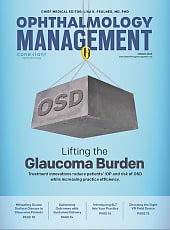Understanding your MAC’s cataract surgery documentation requirements will help your practice and ASC successfully prepare for and pass an audit.
In the fall of 2022, the Centers for Medicare and Medicaid Services (CMS), through the contractor RELI Group, issued a comparative billing report (CBR) on Medicare Part B claims from calendar year 2019.1 The report analyzed several ophthalmology-specific metrics, including the number of cataract surgeries billed as a complex procedure (CPT 66982).
A comparative billing report is not an audit; it is an educational tool that can be used to improve internal provider compliance by drawing attention to individual utilization of specific clinical services. According to the RELI Group, nationally, 8.58 percent of all cataract surgeries were billed as complex procedures in 2019.1
Complex cataract surgery was included in the 2022 CBR because of the rate of improper payments for this service. The 2021 Medicare Fee-for-Service Supplemental Improper Payment Data report projected that 12.7 percent of “eye procedures—cataract removal/lens insertion” would be improperly billed, resulting in over $218,000 in inappropriate payments.2 CMS found that 87.2 percent of the errors that resulted in improper payments were due to insufficient documentation, while the remaining 12.8 percent were due to incorrect coding.3
As cataract surgery, complex cataract surgery, and related services come under increased scrutiny, it is imperative for ambulatory surgical centers (ASCs) to understand the documentation requirements for these high-volume procedures. Meeting these requirements will ensure that the ASC’s revenue is protected and no outside source can recoup funds through an audit.
GENERAL DOCUMENTATION REQUIREMENTS
Medicare Administrative Contractors (MACs) publish local coverage determinations (LCDs) and local coverage articles (LCAs) that include the information needed to avoid insufficient documentation and incorrect coding errors. Commercial payers may publish their own unique policies for procedures. These are often posted on their websites or included in provider manuals. LCDs may vary by region, and they are periodically revised.
When performing complex cataract surgeries, it is important to note that the documentation requirements establishing the medical necessity for standard cataract removal are still required. These vary slightly with each MAC. A detailed list of those requirements is found in the Cataract Surgery Checklist on the opposite page (Figure 1).

ENSURE DOCUMENTATION
Recording a specific activity of daily living that is affected by the cataract is one of the most common documentation deficiencies. Many clinical and operative notes simply list that the patient’s activity of daily living or lifestyle is impacted due to the cataract. This statement is insufficient and does not support the medical necessity for cataract surgery, as there must be a lifestyle complaint that is unique to the patient documented. Auditors may seek to recoup payments if they determine that the patient’s lifestyle complaints are merely general and/or cloned statements.
To avoid the omission of this critical requirement, and to safeguard the surgical center’s reimbursement, a nationally recognized visual function form, such as the Visual Functioning Index Patient Questionnaire (VF-8R), could be used for each eye that needs cataract surgery. The eight questions on the VF-8R could be used as a template to create either a more comprehensive or an abbreviated form, as needed. Not all payers require a formal activities of daily living (ADL) form, so always verify with each payer.
If the surgeon fails an audit of cataract surgery, the ASC facility fee may also be recouped due to the lack of documentation of medical necessity.
DEFINING “COMPLEX”
The definition of CPT code 66982 uses the same wording found in standard cataract surgery (CPT 66984): “Extracapsular cataract extraction removal with insertion of intraocular lens prosthesis (one stage procedure), manual or mechanical technique (e.g., irrigation and aspiration or phacoemulsification), complex,” and then adds this important distinctive statement “requiring devices or techniques not generally used in routine cataract surgery (e.g., iris expansion device, suture support for intraocular lens, or primary posterior capsulorrhexis) or performed on patients in the amblyogenic developmental stage.” The key to indicating that a cataract surgery is complex is clearly documenting in the operative report the why and the how of cataract surgery:
| Why: | The indications (supporting diagnosis) for their use. |
| How: | The devices or techniques used. |
All but one MAC has an LCD or LCA for complex cataract surgery (the exception is WPS Government Health Administrators), and the MACs provide similar indications. A “yes” answer to any of these four questions may help establish whether a case should be coded as complex:
- Does the patient have a miotic pupil that will not dilate sufficiently, thus requiring the use of special instruments?
- Does the IOL need additional support, such as a capsular tension ring or intraocular sutures?
- Is this a pediatrics case that includes the implantation of the IOL?
- Is the cataract considered mature, requiring the use of dye?
With regard to question four, it’s necessary to check the individual payer’s policies, as not all MACs consider the use of dye as a reason to code cataract surgery as complex.4 (To review a current copy of published LCDs for each MAC, visit aao.org/lcds .)
Most cataract cases are identified as complex prior to surgery. However, once the procedure begins, if additional qualifying devices and/or techniques are necessary, used, and documented, be sure that both the physician and facility submits the case as using the complex CPT code 66982. Remember that the determining factor if the cataract surgery qualifies to be coded as complex is based on the use of additional devices or if you are operating on a child, not on the difficulty of the case. ■
REFERENCES
- CMS Releases Comparative Billing Reports on Cataract Surgery. American Academy of Ophthalmology. September 22, 2022. Accessed February 28, 2023. https://www.aao.org/practice-management/news-detail/cms-comparative-billing-reports-cataract-surgery
- 2021 Medicare Fee-for-Service Supplemental Improper Payment Data. U.S. Department of Health and Human Services. Accessed March 10, 2023. https://www.cms.gov/files/document/2021-medicare-fee-service-supplemental-improper-payment-data.pdf-0
- Sample CBR: Mock Provider Data. Accessed February 28, 2023. https://cbr.cbrpepper.org/Portals/0/Documents/CBR_202208/CBR202208_Cataract_Surgery_Sample.pdf?ver=2022-09-12-135820-300
- Cataract Surgeries Can Be Complex, Coding Doesn’t Have to Be. American Academy of Ophthalmology. October 26, 2022. Accessed March 10, 2023. https://www.aao.org/practice-management/news-detail/cataract-surgeries-coding









